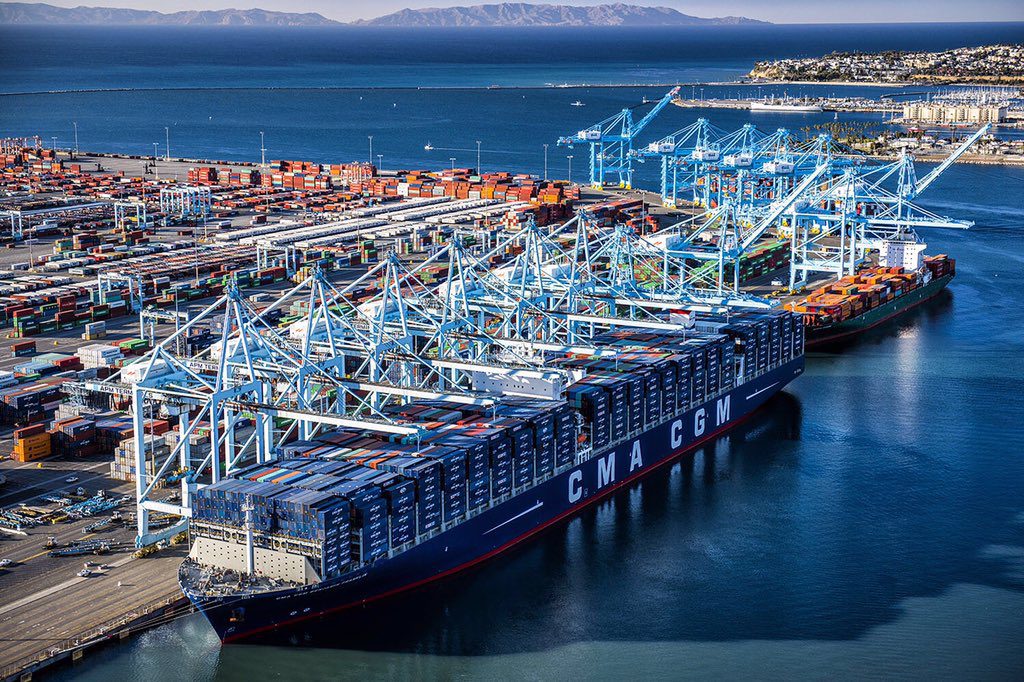The ultra-large container vessel (ULCV) CMA CGM Benjamin Franklin calls at the Port of Los Angeles, December 26, 2015. Photo: Port of Los Angeles
By Mike Wackett (The Loadstar) – Despite a near doubling of the number of 13,000 teu-or-above vessels deployed on the transpacific Asia-US west coast trade this year, the Los Angeles-Long Beach port complex remains unprepared for the introduction of 18,000 teu-plus ULCVs, according to Drewry.
In its latest analysis of the route, Drewry Maritime Research said the number of 13,000 teu vessels on the transpacific increased from 21 in January to 36 in May as carriers cascaded more large tonnage from Asia-Europe trades to accommodate fresh deliveries of ULCVs.
And the lines are likely to cascade even more large tonnage to the transpacific as more ULCVs for Asia-Europe are received.
According to data from Alphaliner, there are 51 18,300-21,400 teu ships due for delivery within the next two years. And there is a suggestion that some could be earmarked for the transpacific.
When the 17,722 teu CMA CGM Benjamin Franklin was trialed on the route in late 2015, Drewry questioned the ability of the LA/LB complex to handle the ship, and proposed similar sized vessels on the service, efficiently.
CMA CGM’s experiment did not last long; after less than five months, CMA CGM’s flagship was quietly replaced by an 11,400 teu vessel.
A big factor in CMA CGM’s subsequent strategy change in 2016 was weakening trade, but with an improved market and healthier freight rates carriers could again be tempted into deploying their biggest ships onto the transpacific.
In the first four months of the year, Drewry noted, combined LA/LB throughput grew 8% on the same period of 2016, to 5.1m teu. Imports were up by 6% to 2.54m teu, while exports increased by 9% to 1.14m teu, with the movement of empty containers rising by 10% to 1.41m teu.
Notwithstanding the “less than perfect” infrastructure and ongoing road closures associated with the Gerald Desmond Bridge replacement project, Drewry cites the “highly-fragmented” terminal complex at LA/LB as having a negative impact on landside operations.
The analyst notes that the “overnight alliance re-shuffle” has again “changed the terminal landscape”.
In the restructure, the 2M + HMM has five weekly services spread across three terminals; the Ocean Alliance has nine services calling at four terminals and THE Alliance has eight loops at four different terminals.
Drewry explained: “Shippers regularly importing from Asia to LA/LB will one week have to collect cargo from String 1 at Terminal A, and the next week the cargo is on String 2 calling at Terminal B.”
And this picture is further complicated by the fact that carriers with ownership of terminals in the port complex still need a return on their investment, as Alphaliner executive consultant Tan Hua Joo pointed out at the recent Transpacific Maritime conference in Long beach.
“The west coast has become very complex, and the terminal situation means it’s become even more difficult for carriers to reduce vessel capacity because they have so much invested in west coast terminals that need volumes.
“Look at OOCL’s new terminal in Long Beach – it is a $2bn investment, but it’s only going to have two calls a week from the new Ocean Alliance services,” he said.
On the land side, terminals that have seen increased business from the alliance reshuffling are, unsurprisingly, faring worse in terms of vehicle turnaround times, according to data compiled by the Harbor Trucking Association (HTA).
Indeed, according to the HTA a doubling of weekly container volumes at the TTI (Total Terminals International) facility at LB, previously owned by Hanjin now under the control of MSC & HMM, has resulted in average truck turn times deteriorating from 87 mins in March to 106 mins in April.
Drewry says a combination of “bigger ships, high-intensity terminal activity and construction work, particularly in the upcoming peak summer months, could create some obstacles”.
Its view is that ULCVs will eventually come to the trade – “but carriers should wait until the ports are completely ready for them”.
The Loadstar is fast becoming known at the highest levels of logistics and supply chain management as one of the best sources of influential analysis and commentary.
Check them out at TheLoadstar.co.uk, or find them on Facebook and Twitter.
Tags:

 Join The Club
Join The Club











